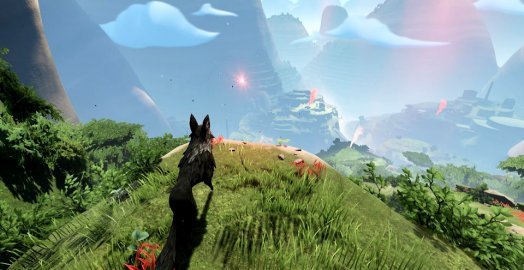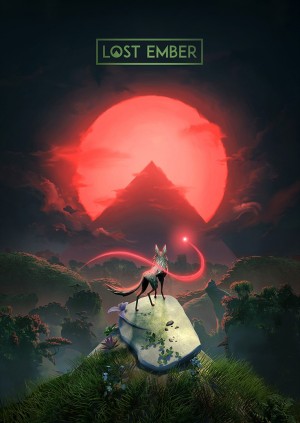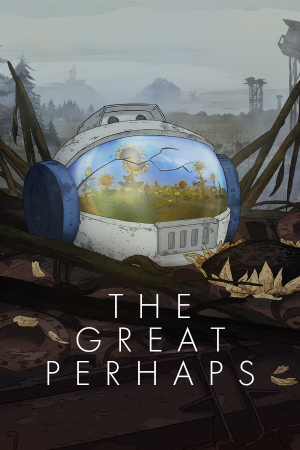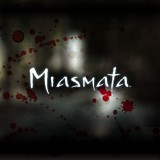Review for Lost Ember

The debut offering of Mooneye Studios, Lost Ember casts players in the form of a wolf with the ability to “soul wander” into other nearby animals, taking them over. Accompanied by a glowing ball / lost spirit sidekick trying to find his way to the afterlife, along the way the protagonist’s past is explored through discoverable memory fragments detailing a story of class conflict within a fictional ancient culture. Swapping controllable animals can be fun and there are some grand vistas to admire whether by land, air or water, but an absence of actual gameplay makes for a hollow journey in this third-person, over-the-shoulder 3D adventure.
Prior to being a wolf, your character was a young woman named Kalani. Both she and her glowing ball sidekick were members of the Yanran (or Yanren or Yanrana depending on which cinematic you’re watching), an ancient culture that built vast stone temples and buildings. Upon death, those of true faith would go on in spirit to the City of Light, while unbelievers would find themselves exiled as orbs of light or else reincarnated as animals. As the game opens, your nameless companion-to-be is roaming over hill and dale trying to find someone that can understand him. Mystical red barriers lie between him and the City of Light, and only through the help of an animal guide can these barriers be broken to allow him to pass.
Throughout the course of the adventure, you control Kalani as the orb follows along, floating through the sky. The goal is to break through all the barriers found in the game’s seven distinct chapters. To do so you will have to locate and watch Kalani’s memory fragments, which have been scattered throughout the environments. Viewing these piecemeal recollections causes the glowing red blockades to crack, and bursting through when sufficiently compromised shatters the barriers so the orb can continue to fly alongside you.
Memory fragments are visibly denoted by red glows on the ground that send up plumes of smoke into the sky. Most of them are placed right in your path, so they rarely require any effort to locate. Once discovered, the press of a button is all it takes to activate a brief new cinematic. These flashbacks are depicted as static tableaus, although in some instances the voices of characters within them can be heard as well. Oftentimes the ruins of ancient Yanran buildings – long since crumbled into decay and now little more than rough stone walls and foundations – are restored to their former grandeur, only to fade away again when the remembrance ends.
Being a wolf, Kalani is unable to tell her story directly and the orb only recalls scattered bits of his former life. Through piecing together the memory fragments, however, a complete narrative is woven of how Kalani witnessed the greatness of the Yanran elite being built on the suffering backs of their society’s poor, thrusting her into the middle of a great class struggle filled with both successes and failures. The tale is told well enough through the tableaus and there’s nothing wrong with the writing or voice acting in these sections, but for all of that I didn’t find myself personally connecting with it that much.
Perhaps my difficulties getting into the backstory stems from the running commentary of the sidekick orb, who I found annoying right from the off. Even in the opening cinematic he’s very self-pitying, self-absorbed, and strikes an almost wheedling tone when he suggests that maybe if Kalani gets him into the City of Light that she could possibly come too. After that, with each memory revisited the orb pipes up with his own thoughts. I don’t know if it was the sad-sounding whiny voice or the script or a combination of both, but even when it seemed like the character should be sympathetic there’s just something I found condescending and judgmental about him. It was a short-lived relief when he decided to leave at one point, only to return moments later as it's still all about him and his needs. Ultimately his attitude comes to make sense in the context of the story, but that doesn’t make it any less grating along the way.
What I enjoyed far more was the main focus of Lost Ember, which is the ability to switch animal forms. While Kalani’s default form is the wolf, when she draws near to another animal a simple tap of a button allows jumping into that animal to take control. For the first four chapters, the number of creatures on offer is relatively limited, and each is used to circumvent terrain that the wolf alone can’t cover. For example, a small mole or armadillo is needed to crawl through low tunnels that your lupine body is too big for, while a duck or hummingbird can be used to cross cavernous gaps. A fish can also be taken over to enter submerged areas, jump up short waterfalls, or wriggle down water-slicked rock slides like a rollercoaster, which I found particularly fun.
The game’s real menagerie doesn’t open up until chapter five. Here the journey shifts from jungle/forest areas to deserts, oases, and snowy crags, and a lot more fauna comes with the change of scenery. The likes of parrots, turtles, fireflies, elephants, goats, and eagles all feature in these locations, most of them having more interesting abilities or opportunities than their predecessors. A pachyderm, for example, can march its way through dense thickets of bamboo poles or smash rocky obstacles in its path, and goats are able to climb nearly vertical cliff faces, which gives a sense of exploratory freedom that even the birds lack since they can never ascend, only maintain their starting height or drift slowly downwards. My favourite, though, would have to be the huge stampeding herd of oxen whom you join to outrun an oncoming sandstorm (which unfortunately ended in a bugged resolution for me but was fun while it lasted). Despite the greater variety of animals here, however, the majority of them are available only briefly, being used just to bypass one or two obstacles. A more even distribution of animals throughout the game would have been much appreciated.
While switching forms is novel early on when first encountering it – and again later when the larger array of creatures is opened up – the problem is that there’s not much to do with the different critters once you control them. If you confine yourself to the main narrative, the experience is a pretty shallow one as all you do is move through the environments from one memory fragment to another, often having to cover looooong distances to do so. (It would have been so nice to have a toggle run button in this game, but alas not.) There’s never any clever strategy needed for animal swapping, or any thinking about it at all really, as the creatures required to bypass an obstacle are always nearby. Think of the animals as keys lying on the ground right in front of the locked doors they are intended to circumvent.
Beyond the main through line, there are some other things that can be done in Lost Ember for those who like collecting items. Scattered throughout the different chapters are a large variety of mushrooms, relics (like small statues, pottery, or utensils), and “legendary” animals to discover. Once unlocked these can be viewed from an in-game menu, but this is all about collecting and adds nothing more to the experience. Even the legendary animals are just glowing versions of their non-legendary counterparts encountered in your travels.
The only other gameplay elements on offer are a few Quick Time Events, such as when turning into a small hummingbird and getting blown into a wind tunnel in the rocks. Here bits of debris must be evaded, which is way easier than it sounds. All that’s required is to repeatedly tap the wing flap button and everything is good. Failing one of these sequences simply resets it to be played again, but if the single button mashing is still too difficult, the game options also kindly allow the QTEs to be turned off. The scenes still play out in this mode but run automatically as cinematics and do not require any input from the player.
The game is controlled by mouse and keyboard or ostensibly a gamepad, although it completely failed to recognize my Logitech controller. The mouse is used to orbit the camera around whatever animal you’re currently inhabiting, while the WASD keys are used for movement. Each animal has some “Silly Stuff” (the game’s own term) that can be done, such as the wolf laying down for a nap or armadillos eating vegetables buried in the ground. They’re nice little touches, although not at all relevant. Every species also has a particular “move” it can perform at the press or hold of a button: moles can role themselves into balls and slide down hills; ducks can flap their wings to reduce the rate at which they drift towards the ground; fish can dart forward to leap from the water. If you want to revert back into wolf form, a tap of a button is all that’s required.
Visually Lost Ember is a bit of a mixed bag. The overall look is quite pleasing, with the diverse environments and animals having a nice semi-realistic, semi-stylized esthetic. Some of the locations are quite grand in their scale: it’s impressive when leaving a claustrophobic tunnel to suddenly find a lush valley with ruined towers and mountains across the way disappearing into the mist, or when mounting a rise overlooking a vast desert and spying the animals below going about their little wanderings.
The downside is that the graphic design as pertains to gameplay can be quite problematic. Environmentally, the first four chapters take place in similar looking lush forests with similar looking stone ruins but rarely are any significant landmarks included, making it fairly easy to become disoriented in some of the larger spaces. At other times, the map layout suggests traversable paths that are not in fact open. One occurred for me when staring at ruins across a large valley that can’t be reached even by flying due to invisible walls in the middle of the air. Another instance involved an eagle flying into a sunset, which I did for over five minutes because it seemed so clearly signposted that that was where I needed to go, when in reality I was supposed to immediately dive through the clouds below.
While the environments are visually quite detailed, the soundscape is surprisingly sparse, though not bad by any means. Beyond the basics of various animal movements – padded footfall for the walking creatures, wing flaps for the birds, etc. – there’s occasional ambient audio for wind and water. Every now and then simple piano and stringed instruments join in for some musical accompaniment, typically when reaching a new area or discovering another memory fragment. It’s pleasing on the ears and contributes to a somewhat Zen-like, peaceful quality that pervades the game, but more music would have been nice to help break up the relative silence the rest of the time.
What would have been even more welcome is if all the bugs had been squashed – and I’m not talking about the insects you can possess. During the six hours I spent completing the game, I ran into multiple issues of varying kinds. To be sure, there was nothing truly game-stopping – no crashes to the desktop, no freezing unresponsiveness – but there were enough little things to rub the shine off. Getting wedged in the geometry, having my animal disappear, falling through the game world (to be respawned back in a safe place), having the music periodically cut in and out at various points, or seeing video cutscenes suddenly go to a slate grey screen even though the audio kept playing were just some of the more common issues I encountered. The only saving grace was the ability to restart from the nearest checkpoint (no free saves in this game, sorry). This would move me back, in wolf form, to a safe place but without any loss of memories or collectibles I’d already found.
As its name suggests, Lost Ember is more of a slow burn that never quite ignites into a full-on fire. It certainly has some impressive visual moments, and it is a kick switching between new animals the first few times. However, with its plethora of bugs, lack of substantive gameplay, and annoying sidekick it’s hard to recommend unequivocally. This is an experience that will probably appeal most to those who like to ferret out all the little hidden items that an open world has to offer. With a huge number of relics, mushrooms, and legendary creatures to find, there’s a lot for collectors to hunt for and some pretty environments to reward exploring more thoroughly. Beyond that, it will probably also resonate with children and the young at heart who might enjoy tooling around inhabiting the forms of different creatures, content to revel in a relaxing journey rather than focus on the destination.
WHERE CAN I DOWNLOAD Lost Ember
Lost Ember is available at:
- GOG -60%
- HumbleBundle
Our Verdict:
Lost Ember’s animal body possession provides some fun moments but the lack of anything substantive to do with it makes for a beautiful but surprisingly empty experience.



_capsule_fog__medium.png)


























